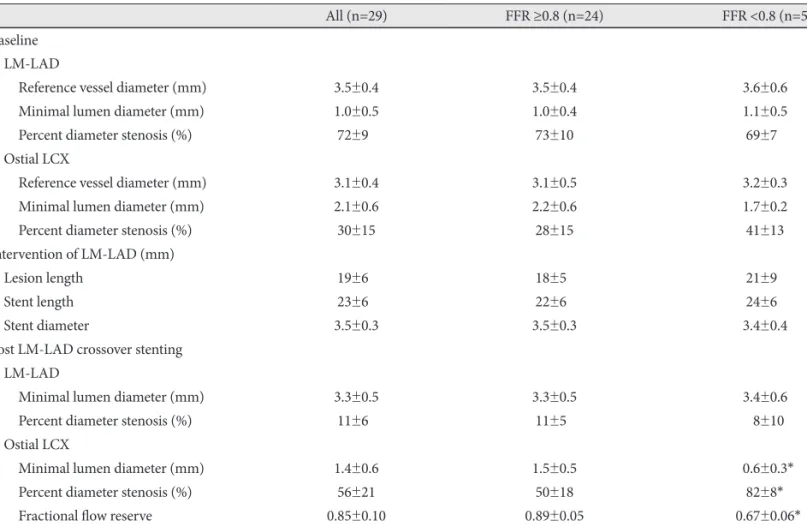304
Print ISSN 1738-5520 / On-line ISSN 1738-5555 Copyright © 2011 The Korean Society of Cardiology ORIGINAL ARTICLE
DOI 10.4070/kcj.2011.41.6.304
Open Access
Fractional Flow Reserve Versus Angiography in Left Circumflex Ostial Intervention After Left Main Crossover Stenting
Chang-Wook Nam, MD
1, Seung-Ho Hur, MD
1, Bon-Kwon Koo, MD
2, Joon Hyung Doh, MD
3, Yun-Kyeong Cho, MD
1, Hyoung-Seob Park, MD
1, Hyuck-Jun Yoon, MD
1, Hyungseop Kim, MD
1, In-Sung Chung, MD
1,
Yoon-Nyun Kim, MD
1, William F. Fearon, MD
4, Seung-Jae Tahk, MD
5, and Kwon-Bae Kim, MD
11
Department of Internal Medicine, Keimyung University College of Medicine, Dongsan Medical Center, Daegu,
2
Department of Internal Medicine, Seoul National University College of Medicine, Seoul,
3
Department of Internal Medicine, Inje University College of Medicine, Ilsan Paik Hospital, Goyang, Korea
4
Stanford University Medical Center, Cardiovascular Medicine, California, USA
5
Department of Internal Medicine, Ajou University School of Medicine, Suwon, Korea
ABSTRACT
Background and Objectives: Discrepancy between angiographic percent (%) diameter stenosis and fractional flow reserve (FFR) exists in non-left main bifurcation lesions. The aim of this study was to compare angiographic stenosis severity and FFR in jailed ostial left circumflex artery (LCX) lesions after left main (LM)-to-left anterior descending artery (LAD) cross- over stenting. Subjects and Methods: Twenty-nine (n=29) patients with distal LM or ostial LAD lesions treated by LM-to- LAD crossover stenting were consecutively enrolled. After successful stenting, FFR was measured at the jailed LCX. Addi- tional intervention was performed in lesions with FFR <0.8. Results: The mean reference diameter of LCX was 3.1±0.4 mm, and percent diameter stenosis after crossover stenting was 56±21%. Angiographically significant stenosis (>50%) at the osti- al LCX occurred in 59% (17/29) of cases. Among them, only five (29%) lesions had functional significance, and underwent additional procedure. During follow-up, three patients in the deferral group and two patients in the additional intervention group had target lesion revascularization. Conclusion: There was a discrepancy between angiographic percent diameter stenosis and FFR in jailed LCX lesions after LM crossover stenting. (Korean Circ J 2011;41:304-307)
KEY WORDS: Coronary disease; Physiology; Stents; Angiography.
Received: June 19, 2010
Revision Received: September 3, 2010 Accepted: October 14, 2010
Correspondence: Seung-Ho Hur, MD, Division of Cardiology, Depart- ment of Internal Medicine, Keimyung University College of Medicine, Dongsan Medical Center, 216 Dalseong-ro, Jung-gu, Daegu 700-712, Korea
Tel: 82-53-250-7949, Fax: 82-53-250-7034 E-mail: shur@dsmc.or.kr
• The authors have no financial conflicts of interest.
cc
